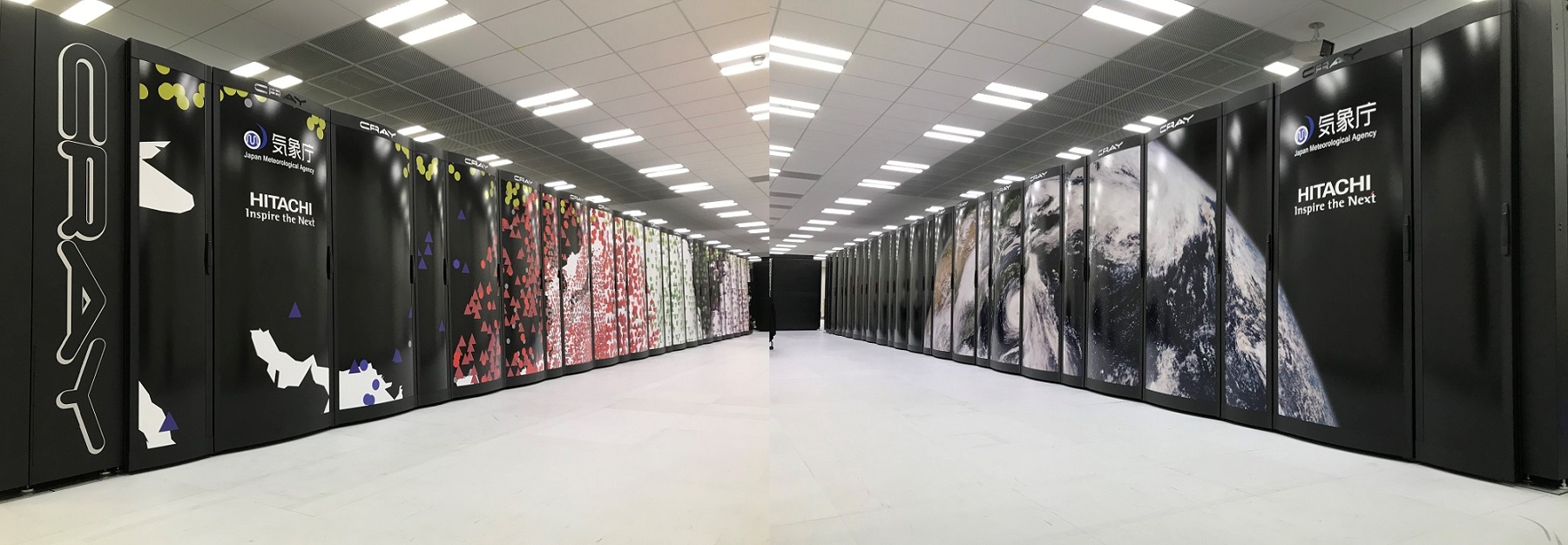Cray has supplied two identical Cray XC50 supercomputers to the Japan Meteorological Agency (JMA) in northwestern Tokyo. Boasting more than 18 petaflops combined peak computing capacity, the new systems will extend the agency’s ability to understand, model and predict the atmosphere and ocean and conduct general weather forecasting. The powerful HPC systems are critical to enabling the island nation to guard against natural threats such as typhoons and heavy rainfall.
Long-time center partner Hitachi is the prime contractor and system integrator on the contract, which, according to Japanese news reports, is valued at 4 billion yen (US $36 million). Another $6 billion yen (US $54 million) will go toward operating costs over the next five years.

The new Cray XC50s, with Intel Xeon Skylake processors and three Lustre file systems each, are a significant upgrade for the meteorological agency. JMA’s IBM Power 775-based Hitachi SR16000/M1 supercomputer turned six this year. Installed in 2012 the system consists of two independent SR16000/M1s machines, with a combined peak performance of 847 teraflops (423.5 teraflops each).
A Japanese news outlet reported that the 10X performance boost provided by the Crays will enable JMA scientists to make detailed rainfall forecasts 15 hours ahead of time, instead of six hours.
“By keeping track of the potential impact of typhoons and localized downpours at an early stage, we can help local governments to issue earlier evacuation orders and take other disaster prevention steps more swiftly,” said an agency official, cited by Equities.com.
The same publication reported that by this time next year, agency researchers expect to forecast typhoons five days in advance instead of three and predict average temperatures two weeks out.
The two new Crays have already been delivered and will be brought into production over the next few months. The aggregate computing power should be sufficient to bring JMA back onto the Top500 rankings (if the agency opts to submit), where it could come in ahead of the pack of weather forecasters that is currently led by the UK Met Office with a 7 petaflops (Linpack) Cray XC40 supercomputer at number 15. The last time JMA had a Top500 machine was in 2008 with two Hitachi SR11000-K1/80 clusters. (Its 2012-era Hitachi SR16000/M1s did not enter the Top500 list despite having peak numbers about ~2x higher than the machines near the cut-off; we don’t know if the lack of showing was due to poor Linpack-to-peak efficiency or if JMA never submitted those machines.)
Cray has built a thriving business in the weather forecasting sector and its XC40 line has been particularly popular. In the United States, NOAA operates two Cray XC40s, installed in 2015. In the UK, the MET Office and the ECMWF count five Cray XC40s between them. The Ministry of Earth Sciences in India deployed two Cray XC40 supercomputers and two Cray ClusterStor storage systems earlier this year. Germany (Deutscher Wetterdienst), Korea (Meteorological Administration) and Australia (Bureau of Meteorology) also rely on Cray XC40s.
It’s not just national numerical weather prediction sites that are purchasing Crays, but university centers too. Take for example the Disaster Prevention Research Institute (DPRI) within Kyoto University, which is using a Cray XC40 with Intel Xeon Phi processors to contribute to Japan’s preparedness efforts.
Formed in 1956 and headquartered in Chiyoda, Tokyo, the Japan Meteorological Agency, JMA, serves the Japanese public, aviation and marine interests, providing weather forecasts and issuing warnings for earthquakes, tsunamis, typhoons and volcanic eruptions.






























































